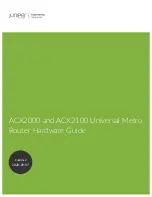
190
Configuring IEEE 802.1x Port-Based Authentication
Information About Configuring IEEE 802.1x Port-Based Authentication
To resolve Windows XP network connectivity and 802.1x authentication issues, read the Microsoft Knowledge
Base article:
http://support.microsoft.com/support/kb/articles/Q303/5/97.ASP
Authentication server
—Performs the actual authentication of the client. The authentication server validates the
identity of the client and notifies the switch whether or not the client is authorized to access the LAN and switch
services. Because the switch acts as the proxy, the authentication service is transparent to the client. In this release,
the RADIUS security system with Extensible Authentication Protocol (EAP) extensions is the only supported
authentication server. It is available in Cisco Secure Access Control Server Version 3.0 or later. RADIUS operates in
a client/server model in which secure authentication information is exchanged between the RADIUS server and one
or more RADIUS clients.
Switch
(edge switch or wireless access point)—Controls the physical access to the network based on the
authentication status of the client. The switch acts as an intermediary (proxy) between the client and the
authentication server, requesting identity information from the client, verifying that information with the
authentication server, and relaying a response to the client. The switch includes the RADIUS client, which is
responsible for encapsulating and decapsulating the EAP frames and interacting with the authentication server. (The
switch is the
authenticator
in the 802.1x standard.)
When the switch receives EAPOL frames and relays them to the authentication server, the Ethernet header is
stripped, and the remaining EAP frame is re-encapsulated in the RADIUS format. The EAP frames are not modified
during encapsulation, and the authentication server must support EAP within the native frame format. When the
switch receives frames from the authentication server, the server’s frame header is removed, leaving the EAP frame,
which is then encapsulated for Ethernet and sent to the client.
The devices that can act as intermediaries (switches, or a wireless access point) must be running software that
supports the RADIUS client and 802.1x authentication.
Authentication Process
When 802.1x port-based authentication is enabled and the client supports 802.1x-compliant client software, these
events occur:
If the client identity is valid and the 802.1x authentication succeeds, the switch grants the client access to the
network.
If 802.1x authentication times out while waiting for an EAPOL message exchange and MAC authentication bypass is
enabled, the switch can use the client MAC address for authorization. If the client MAC address is valid and the
authorization succeeds, the switch grants the client access to the network. If the client MAC address is invalid and
the authorization fails, the switch assigns the client to a guest VLAN that provides limited services if a guest VLAN
is configured.
If the switch gets an invalid identity from an 802.1x-capable client and a restricted VLAN is specified, the switch can
assign the client to a restricted VLAN that provides limited services.
If the RADIUS authentication server is unavailable (down) and inaccessible authentication bypass is enabled, the
switch grants the client access to the network by putting the port in the critical-authentication state in the
RADIUS-configured or the user-specified access VLAN.
Note:
Inaccessible authentication bypass is also referred to as critical authentication or the AAA fail policy.
Summary of Contents for IE 4000
Page 12: ...8 Configuration Overview Default Settings After Initial Switch Configuration ...
Page 52: ...48 Configuring Interfaces Monitoring and Maintaining the Interfaces ...
Page 108: ...104 Configuring Switch Clusters Additional References ...
Page 128: ...124 Performing Switch Administration Additional References ...
Page 130: ...126 Configuring PTP ...
Page 140: ...136 Configuring CIP Additional References ...
Page 146: ...142 Configuring SDM Templates Configuration Examples for Configuring SDM Templates ...
Page 192: ...188 Configuring Switch Based Authentication Additional References ...
Page 244: ...240 Configuring IEEE 802 1x Port Based Authentication Additional References ...
Page 298: ...294 Configuring VLANs Additional References ...
Page 336: ...332 Configuring STP Additional References ...
Page 408: ...404 Configuring DHCP Additional References ...
Page 450: ...446 Configuring IGMP Snooping and MVR Additional References ...
Page 490: ...486 Configuring SPAN and RSPAN Additional References ...
Page 502: ...498 Configuring Layer 2 NAT ...
Page 770: ...766 Configuring IPv6 MLD Snooping Related Documents ...
Page 930: ...926 Configuring IP Unicast Routing Related Documents ...
Page 976: ...972 Configuring Cisco IOS IP SLAs Operations Additional References ...
Page 978: ...974 Dying Gasp ...
Page 990: ...986 Configuring Enhanced Object Tracking Monitoring Enhanced Object Tracking ...
Page 994: ...990 Configuring MODBUS TCP Displaying MODBUS TCP Information ...
Page 996: ...992 Ethernet CFM ...
Page 1066: ...1062 Using an SD Card SD Card Alarms ...
















































